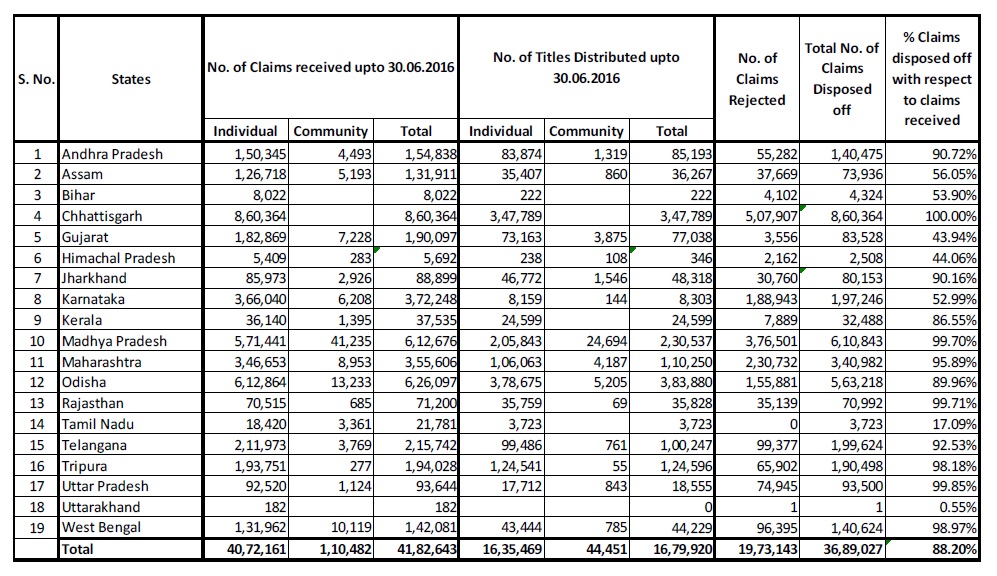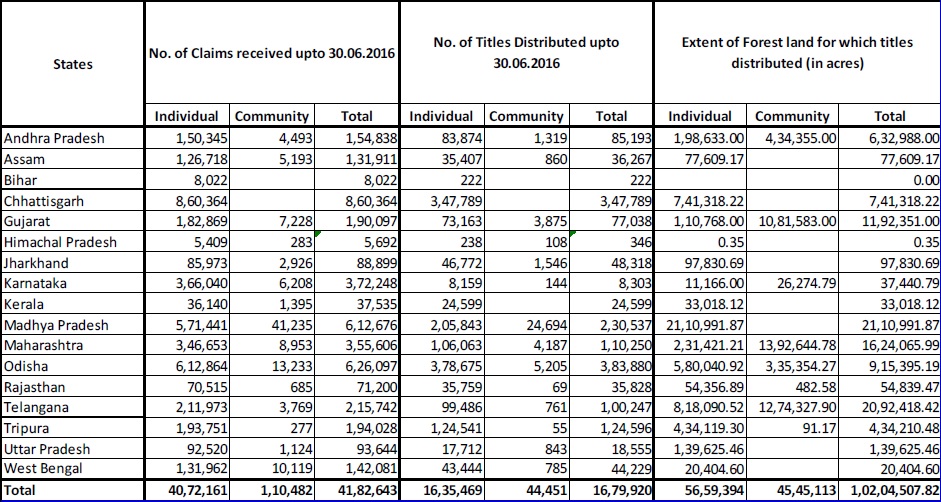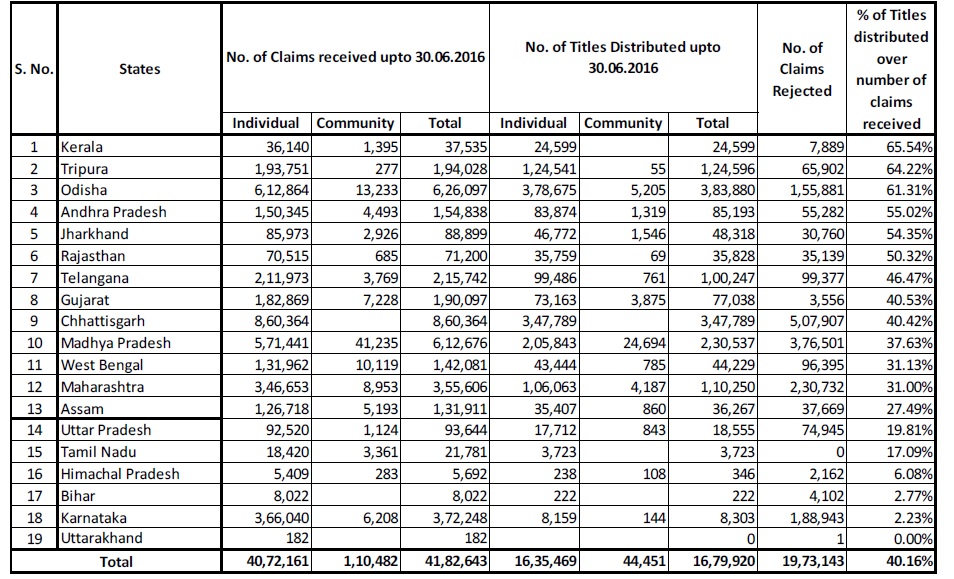Poor forest rights act implementation hampers social justice to the tribals
Access to land and its resources is important since it determines the extent of poverty and deprivation one faces. Historically tribal populations and other traditional forest dwellers did not enjoy any legal entitlement such as ownership rights or user rights of the forest lands where they had been living since ages, both communally and individually. The Forest Rights Act (FRA) is, thus, seen as a progressive legislation that attempted to correct the “historic injustice” that was done to the forest dwellers and the tribals in the past.
Under the FRA, individuals and communities can apply for title claims before the Gram Sabha, based on which the latter makes recommendation to the Sub Divisional Level Committee (SDLC) such as who has been cultivating land for how long, which minor forest produce is collected, etc. The SDLC further recommends the claims to the District Level Committee (DLC) for final approval.
The Ministry of Tribal Affairs (MoTA) has recently released data on the progress in implementation of the Forest Rights Act (2006). The latest available data shows that at the national level (based on aggregation of data for 19 states) the number of title claims rejected as a proportion of the total number of claims that were disposed off has been 53.5 percent, as on 30 June, 2016. Please see table-1.
Table 1: Statement of claims and distribution of title deeds under the Scheduled Tribes and Other Traditional Forest Dwellers (Recognition of Forest Rights) Act (2006) as on 30 June 2016
Under the FRA, individuals and communities can apply for title claims before the Gram Sabha, based on which the latter makes recommendation to the Sub Divisional Level Committee (SDLC) such as who has been cultivating land for how long, which minor forest produce is collected, etc. The SDLC further recommends the claims to the District Level Committee (DLC) for final approval.
The Ministry of Tribal Affairs (MoTA) has recently released data on the progress in implementation of the Forest Rights Act (2006). The latest available data shows that at the national level (based on aggregation of data for 19 states) the number of title claims rejected as a proportion of the total number of claims that were disposed off has been 53.5 percent, as on 30 June, 2016. Please see table-1.
Table 1: Statement of claims and distribution of title deeds under the Scheduled Tribes and Other Traditional Forest Dwellers (Recognition of Forest Rights) Act (2006) as on 30 June 2016

Source: Monthly update on status of implementation of the Scheduled Tribes and Other Traditional Forest Dweller (Recognition of Forest Rights) Act, 2006, Ministry of Tribal Affairs, 10 August, 2016, please click here to access
The total number of claims rejected as a proportion of the total number of claims disposed off varies greatly from one state to another. For example, calculations done by the Inclusive Media for Change team (based on data provided in table-1) shows that in Bihar this proportion stands at 94.9 percent whereas for Chhattisgarh the same has been 59 percent, as on 30 June 2016.
From the table-1 it could be observed that at the national-level (based on aggregation of data for 19 states) 40.72 lakh number of title claims by individuals and 1.1 lakh number of title claims by communities were filed as on 30 June, 2016.
The number of individual claims for titles filed ranges from 182 in Uttarakhand to 8.6 lakh in Chhattisgarh, as on 30 June, 2016. Similarly, the number of community claims for titles ranges from zero in Bihar, Chhattisgarh & Uttarakhand to 41,235 in Madhya Pradesh, during the same period.
The latest available data from the table-1 shows that the total number of claims disposed off as a proportion of total number of claims received ranges from 0.6 percent in Uttarakhand to 100 percent in Chhattisgarh, as on 30 June 2016.
Table 2: State-wise details of claims received, titles distributed and the extent of forest land for which titles distributed (individual and community), as on 30 June, 2016, in major states
The total number of claims rejected as a proportion of the total number of claims disposed off varies greatly from one state to another. For example, calculations done by the Inclusive Media for Change team (based on data provided in table-1) shows that in Bihar this proportion stands at 94.9 percent whereas for Chhattisgarh the same has been 59 percent, as on 30 June 2016.
From the table-1 it could be observed that at the national-level (based on aggregation of data for 19 states) 40.72 lakh number of title claims by individuals and 1.1 lakh number of title claims by communities were filed as on 30 June, 2016.
The number of individual claims for titles filed ranges from 182 in Uttarakhand to 8.6 lakh in Chhattisgarh, as on 30 June, 2016. Similarly, the number of community claims for titles ranges from zero in Bihar, Chhattisgarh & Uttarakhand to 41,235 in Madhya Pradesh, during the same period.
The latest available data from the table-1 shows that the total number of claims disposed off as a proportion of total number of claims received ranges from 0.6 percent in Uttarakhand to 100 percent in Chhattisgarh, as on 30 June 2016.
Table 2: State-wise details of claims received, titles distributed and the extent of forest land for which titles distributed (individual and community), as on 30 June, 2016, in major states

Source: Monthly update on status of implementation of the Scheduled Tribes and Other Traditional Forest Dweller (Recognition of Forest Rights) Act, 2006, Ministry of Tribal Affairs, 10 August, 2016, please click here to access
The monthly update on the status of implementation of the FRA, which was released in August, 2016, indicates that out of the 1.02 crore acres of total forest land for which titles have been distributed in 17 major states altogether, nearly 56.6 lakh acres (i.e. 55.5 percent) was meant for individual title claims and 45.5 lakh (i.e. 44.5 percent) acres was meant for community title claims, as on 30 June, 2016. Please check table-2.
Table 3: Statement showing ranking in terms of percentage of titles distributed over number of claims received in each state under the Scheduled Tribes and Other Traditional Forest Dwellers (Recognition of Forest Rights) Act, 2006 as on 30 June, 2016
Table 3: Statement showing ranking in terms of percentage of titles distributed over number of claims received in each state under the Scheduled Tribes and Other Traditional Forest Dwellers (Recognition of Forest Rights) Act, 2006 as on 30 June, 2016

Source: Monthly update on status of implementation of the Scheduled Tribes and Other Traditional Forest Dweller (Recognition of Forest Rights) Act, 2006, Ministry of Tribal Affairs, 10 August, 2016, please click here to access
At the national-level (based on aggregation of data for 19 states shown in table-3) the number of titles distributed as a proportion of the number of claims received has been 40.2 percent as on 30 June 2016. The percentage of titles distributed over number of claims received varies from zero in Uttarakhand to 65.5 percent in Kerala.
From the table-3 it can be found that the total number of titles (individual + community) distributed upto 30 June, 2016 varies from zero in Uttarakhand to 3.8 lakh in Odisha.
The monthly update on FRA implementation status, which was released in August, 2016, also shows that among the 10 states affected by Left Wing Extremism (LWE), the number of claims rejected as a proportion of the total number of claims disposed off has been the highest in Bihar (94.9 percent). The percentage of claims disposed off with respect to total number of claims received has been the highest in Chhattisgarh (100 percent) and lowest in Bihar (53.9 percent).
Does the Compensatory Afforestation Fund legislation contradict FRA?
Under the FRA, it is the Gram Sabha which decides whether a project can take place inside the forest or a conservation plan for forest can be carried out by the Government.
The Compensatory Afforestation Fund (CAF) Bill in its current form, however, bypasses the authority of Gram Sabha, thus, contradicting the FRA, alleges tribal rights activists and environmentalists.
Afforestation activities carried out by forest bureaucracy in the past had failed to increase forest cover. It has, therefore, been demanded by the civil society activists that local communities are taken along to restore forests and degraded lands. The use of CAF funds for community-based afforestation is expected to be more fruitful as compared to forest bureaucracy-led efforts. However, the CAF Bill passed recently does not take into consideration the Gram Sabha's consent for any afforestation activity.
Neera Singh in her Indian Express article entitled Whose forests are these anyway? says that the CAF Bill is silent about compensation to forest communities (instead of state governments) in case of loss of forests.
It needs to be mentioned that nearly Rs. 40,000 crore has been collected by the Compensatory Afforestation, Management and Planning Authority (ad-hoc) since 2006 as compensation for diverting forest land for non-forestry purposes, following a Supreme Court order.
The CAF Bill, according to a press release from the Ministry of Environment and Forests (dated 28 July, 2016), provides for transfer of 90 percent of the accumulated amount, which presently is of the order of around Rs. 40,000 crores (excluding about Rs. 2000 crores of interest already accrued on the amount presently being kept as FDs) to the states for creation and maintenance of compensatory afforestation and execution of other activities for conservation, protection, improvement and expansion of forest and wildlife resources of the country. The remaining 10 percent of the entire fund retained at the national-level will be used for monitoring and evaluation of activities that are undertaken by the states/ UTs and Central Government, and to provide, research and technical support to the states so as to ensure that these amounts are used in the best possible manner technically.
As per the Ministry of Environment and Forests, the CAF Bill provides for establishment of a permanent institutional framework to ensure utilization of these funds in an expeditious and transparent manner.
The Central Government while according prior approval under the Forest (Conservation) Act, 1980 for diversion of forest land for non-forest purpose stipulates conditions to the effect that the state government shall realize funds from the user agency for compensatory afforestation, catchment area treatment plan, wildlife management plan etc. so as to mitigate the impact of diversion of forest land. In most of the states, funds received from the user-agencies were deposited in consolidated fund as revenue receipts, which were made available to the Forest Department through budgetary provisions.
The Rajya Sabha passed The Compensatory Afforestation Fund Bill, 2016 on 28 July, 2016. The Bill had earlier been passed by Lok Sabha in May 2016.
It must be noted that in the year 2008 the Central Government formulated the Compensatory Afforestation Fund Bill, 2008, which was passed by the Lok Sabha on 23 December, 2008. However, the Bill could not be taken up for discussion in Rajya Sabha. On dissolution of the 14th Lok Sabha, that Bill lapsed.
About the Forest Rights Act
The FRA, which is also known as the Scheduled Tribes and Other Traditional Forest Dwellers (Recognition of Forest Rights) Act (2006) recognises and vests the forest rights and occupation in forest land of forest dwelling Scheduled Tribes and other traditional forest dwellers who had been residing in such forest for generations but whose rights could not be recorded. The rights under the FRA include the right to collect and sell minor forest produce and the right to live in the forest land for habitation or self-cultivation for livelihood, etc., says a policy brief from the PRS Legislative Research (2013).
Many of the Latin American countries like Brazil, Mexico and Bolivia started recognising the land rights of forest dwellers long back as compared to India.
As per the FRA, the cut-off date has been fixed as 13 December, 2005. It means that the FRA recognises a land that has been already under cultivation by a person from Scheduled Tribe background as on 13 December 2005 and not any forest land where cultivation started after that date.
In order to be eligible for entitlement to land rights and the right to collect and market the forest products (like tendu leaves, herbs, medicinal plants etc.), the claimant would have to be residing in forest land for 75 years prior to December 2005 (applicable only in case of Other Traditional Forest Dwellers). One is also required to be a member of a Scheduled Tribe for being eligible to claim land title.
A person can claim upto 4 acres of land, which s/he has been cultivating for a livelihood prior to 13 December, 2005.
References:
Monthly update on status of implementation of the Scheduled Tribes and Other Traditional Forest Dweller (Recognition of Forest Rights) Act, 2006, Ministry of Tribal Affairs, 10 August, 2016, please click here to access
Press Release: Compensatory Afforestation Fund Bill, 2016 passed by Rajya Sabha, Ministry of Environment and Forests, Press Information Bureau, 28 July, 2016, please click here to access
FAQ on the Forest Rights Act, Ministry of Tribal Affairs, please click here to access
The Scheduled Tribes and Other Traditional Forest Dwellers (Recognition of Forest Rights) Act (2006), please click here to access
The Scheduled Tribes and Other Traditional Forest Dwellers (Recognition of Forest Rights) Amendment Rules, 2012, PRS Legislative Research, 21 January, 2013, please click here to access
Forest Rights Act: What is this Act about? , please click here to access
Understanding the Compensatory Afforestation Fund Bill and why it spells doom for adivasi rights, Scroll.in, 1 August, 2016, please click here to access
India's forests: Whose land is it anyway? -Nitin Sethi, Business Standard, 1 August, 2016, please click here to access
Down memory lane: Forest Rights Act yet to achieve major milestones -G Seetharaman, The Economic Times, 31 July, 2016, please click here to access
Whose forests are these anyway? -Neera Singh, The Indian Express, 28 July, 2016, please click here to access
States rejected 8 out of every 10 claims for land by tribals last year -Kumar Sambhav Shrivastava, Hindustan Times, 28 July, 2016, please click here to access
The Scheduled Tribes and Other Traditional Forest Dwellers (Recognition of Forest Rights) Amendment Rules, 2012, PRS Legislative Research, 21 January, 2013, please click here to access
Forest Rights Act: What is this Act about? , please click here to access
Understanding the Compensatory Afforestation Fund Bill and why it spells doom for adivasi rights, Scroll.in, 1 August, 2016, please click here to access
India's forests: Whose land is it anyway? -Nitin Sethi, Business Standard, 1 August, 2016, please click here to access
Down memory lane: Forest Rights Act yet to achieve major milestones -G Seetharaman, The Economic Times, 31 July, 2016, please click here to access
Whose forests are these anyway? -Neera Singh, The Indian Express, 28 July, 2016, please click here to access
States rejected 8 out of every 10 claims for land by tribals last year -Kumar Sambhav Shrivastava, Hindustan Times, 28 July, 2016, please click here to access
Image Courtesy: Inclusive Media for Change/ Shambhu Ghatak
